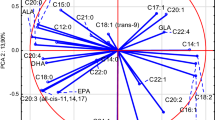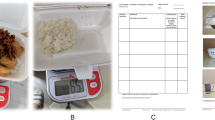Abstract
Objective: To measure the bioavailability of selenium from cooked and raw fish in humans by estimating and comparing apparent absorption and retention of selenium in biosynthetically labelled fish with labelled selenate and biosynthetically labelled selenium in brewers yeast.
Design: The intervention study was a parallel, randomised, reference substance controlled design carried out at two different centres in Europe.
Setting: The human study was carried out at the Institute of Food Research, Norwich, UK and at TNO Nutrition and Food Research, Zeist, The Netherlands.
Subjects: In all, 35 male volunteers aged 18–50 y were recruited; 17 subjects were studied in Norwich (UK) and 18 in Zeist (Netherlands). All of the recruited subjects completed the study.
Interventions: Biosynthetically labelled trout fish (processed by two different methods), biosynthetically labelled brewers yeast and isotopically labelled selenate were used to estimate selenium apparent absorption and retention by quantitative analysis of stable isotope labels recovered in faeces and urine. Subjects consumed the labelled foods in four meals over two consecutive days and absorption was measured by the luminal disappearance method over 10 days. Urinary clearance of isotopic labels was measured over 7 days to enable retention to be calculated.
Results: Apparent absorption of selenium from fish was similar to selenate and there was no difference between the two processing methods used. However, retention of fish selenium was significantly higher than selenate (P<0.001). Apparent absorption and retention of yeast selenium was significantly different (P<0.001) from both fish selenium and selenate.
Conclusions: Fish selenium is a highly bioavailable source of dietary selenium. Cooking did not affect selenium apparent absorption or retention from fish. Selenium from yeast is less bioavailable.
This is a preview of subscription content, access via your institution
Access options
Subscribe to this journal
Receive 12 print issues and online access
$259.00 per year
only $21.58 per issue
Buy this article
- Purchase on Springer Link
- Instant access to full article PDF
Prices may be subject to local taxes which are calculated during checkout
Similar content being viewed by others
References
Akesson B & Srikumar TS (1994): Occurrence of low-molecular-weight and high-molecular-weight selenium compounds in fish. Food Chem. 51, 45–49.
Alfthan G, Aro A, Arvilomni H & Huttunen J (1991): Selenium metabolism and platelet glutathione peroxidase activity in healthy Finnish men: effects of selenium yeast, selenite and selenate. Am. J. Clin. Nutr. 53, 120–125.
Allan CB, Lacourciere GM & Stadtman TC (1999): Responsiveness of selenoproteins to dietary selenium. Ann. Rev. Nutr. 19, 1–16.
Atherton C, Fox T, Fairweather-Tait S, Dainty J, Lewis J, Baxter M, Crews H & Langford N (2000): Absorption of selenium from biosynthetically labelled foods in humans. In Trace Elements in Man and Animals — TEMA 10, eds A Favier, RA Anderson & AM Roussel, 178 pp. New York: Plenum.
Barclay MNI & McPherson A (1992): Selenium content of wheat for breadmaking in Scotland and the relationship between glutathione peroxidase levels in whole blood and bread consumption. Br. J. Nutr. 8, 261–270.
Behne D, Weiss-Nowak C, Kalcklosch M, Westphal C, Gessner H & Kyriakopoulos A (1995): Studies on the distribution and characteristics of new mammalian selenium-containing proteins. Analyst 120, 823–825.
Bergmann S, Neumeister V, Siekmeier R, Mix C, Wahrburg V & Jaross W . (1998): Toxicol. Lett. 18, 196–197.
Bird SM, Uden PC, Tyson JF, Block E & Denoyer E (1997): Speciation of selenoaminoacids and organoselenium compounds in selenium-enriched yeast using high-performance liquid chromatography-inductively coupled plasma mass spectrometry. J. Anal. At. Spectrom. 12, 785–788.
Burke RF & Hill KE (1993): Regulation of selenoproteins. Ann. Rev. Nutr. 13, 65–81.
Cappon CJ & Smith JC (1982): Chemical form and distribution of mercury and selenium in canned tuna. J. Appl. Toxicol. 2, 181–189.
Combs Jr GF & Clark LC (1999): Selenium and cancer. In Nutritional Oncology, eds. D Heber, GL Blackburn & VLW Go, pp 215–222. New York, NY: Academic Press.
Diplock AT (1987): Trace elements in human health with special reference to selenium. Am. J. Clin. Nutr. 45, 1313–1322.
Dreosti I (1986): Selenium. J. Food. Nutr. 43, 60–78.
Esaki N, Nakamura T, Tanaka H & Sada K (1982): Selenocysteine lyase, a novel enzyme that specifically acts on selenocysteine. Mammalian distribution and purification and properties of pig liver enzyme. J. Biol. Chem. 257, 4386–4391.
Food Standards Agency (2002): Mc Lance and Widdowsen's. The Composition of Foods, Sixth Summary edition. Cambridge: Royal Society of Chemistry.
Fox T, Atherton C, Fairweather-Tait S, Dainty J, Lewis J, Baxter M & Crews H (2000): Changes in indices of selenium status in men on low, medium and high intakes. In Trace Elements in Man and Animals — TEMA 10, eds. A Favier, RA Anderson & AM Roussel, 67 pp. New York: Plenum.
Griffiths NM, Stewart RDH & Robinson MF (1976): The metabolism of [75Se]selenomethionine in four women. Br. J. Nutr. 35, 373–382.
Hagmar L, Persson-Moschos M, Akkesson B & Shutz A (1998): Plasma levels of selenium, selenoprotein P and glutathione peroxidase and their correlations to fish intake and serum levels of thyrotropin and thyroid hormones: a study on Latvian fish consumers. Eur. J. Clin. Nutr. 52, 796–800.
Hocking RR (1996): Methods and Applications of Linear Models: Regression and the Analysis of Variance. New York: Wiley.
Korhola M, Vainio A & Edelmann K (1986): Selenium yeast. Ann. Clin. Res. 18, 65–68.
Levander OA (1983): Considerations in the design of selenium bioavailability studies. Fed. Proc. 42, 1721–1725.
Lorentzen M, Maage A & Julshamn C (1994): Effects of dietary selenite or selenomethionine on tissue selenium levels of Atlantic salmon (Salmo salar). Aquaculture 121, 359–367.
Meltzer HM, Bibow K, Paulsen IT, Mundal HH, Norheim G & Holm H (1993): Different Bioavailability in humans of wheat and fish selenium as measured by blood-platelet response to increased dietary Se. Biol. Trace Elem. Res. 36, 229–241.
Mutanen M (1986): Bioavailability of selenium. Ann. Clin. Res. 18, 48–54.
Onning G & Bergdahl IA (1999): Fractionation of soluble selenium compounds from fish using size-exclusion chromatography with on-line detection by inductively coupled plasma mass spectrometry. Analyst 24, 1435–1438.
Quijano MA, Moreno P, Gutierrez AM, Concepcion M, Perez-Conde MC & Camara C (2000): Selenium speciation in animal tissue after enzymatic digestion by high-performance liquid chromatography coupled to inductively coupled plasma mass spectrometry. J. Mass Spectrom. 35, 878–884.
Rayman M . (2000): The importance of selenium to health. Lancet 356, 233–241.
Richold M, Robinson MF & Stewart RDH (1977): Metabolic studies in rats of 75Se incorporated in vivo into fish muscle. Br. J. Nutr. 38, 19–29.
Robinson MF & Thomson CD (1983): The role of selenium in the diet. Nutr. Abst. Rev. Clin. Nutr. 53, 3–26.
Robinson MF, Rea M, Friend GM, Stewart RDH, Snow PC & Thomson CD (1978): On supplementing the selenium intake of New Zealanders 2. Prolonged metabolic experiments with daily supplements of selenomethionine, selenite and fish. Br. J. Nutr. 39, 589–600.
Robinson MF, Jenkinson G & Luzhen G (1989): Urinary excretion of selenium (Se) and trimethylselenonium (TMSe) by NZ women during long term supplementation with selenate or selenomethionine (SeMet). In: Selenium in Biology and Medicine, ed. A Wendel, pp 250–253. Berlin: Springer-Verlag.
Shennan DB (1988): Selenium (selenate) transport by human placental brush border membrane vesicles. Br. J. Nutr. 59, 13–19.
Sirichakwal PP, Young VR & Janghorbani M (1985): Absorption and retention of selenium from intrinsically labelled egg and selenite as determined by stable isotope studies in humans. Am. J. Clin. Nutr., 41, 264–269.
StatSoft Inc.(2000): STATISTICA for Windows v 5.5 [computer program], StatSoft Inc., Tulsa, OK, USA.
Stewart RDH, Griffiths NM, Thomson CD & Robinson MF (1978): Quantitative selenium metabolism in normal New Zealand women. Br. J. Nutr. 40, 45–54.
Suhajda A, Hegoczki J, Janzso B, Pais I & Vereczkey G (2000): Preparation of selenium-enriched Saccharomyces cerevisiae. J. Trace Elem. Med. Biol. 14, 43–47.
Swanson CA, Patterson BH, Levander OA, Veillon C, Taylor PR, Helzlsover K, McAdam PA & Zech LA (1991): Human 74Se-selenomethionine metabolism: A kinetic model. Am. J. Clin. Nutr. 54, 917–926.
Thomson CD, Robinson BA, Stewart RD & Robinson MF (1975): Metabolic studies of [75Se]selenocystine and [75Se]selenomethionine in the rat. Br. J. Nutr. 34, 501–509.
Thomson CD, Burton CE & Robinson MF (1978): On supplementing the selenium intake of New Zealanders. 1. Short experiments with large doses of selenite or selenomethionine. Br. J. Nutr. 39, 579–587.
Thomson CD, Robinson MF, Butler JA & Whanger PD (1993): Long term supplementation with selenate and selenomethionine on selenium and glutathione peroxidase in blood components of New Zealand women. Br. J. Nutr. 69, 577–588.
Van Dokkum W (1995): The intake of selected minerals and trace elements in European countries. Nutr. Res. Rev. 8, 271–302.
Wen HY, Davis RL, Shi B, Chen JJ, Chen L, Boylan M & Spallholz JE (1997): Bioavailability of selenium from veal,chicken, beef, pork, lamb, flounder, tuna, selenomethionine, and sodium selenite assessed in selenium-deficient rats. Biol. Trace Elem. Res. 58, 43–53.
World Health Organisation (1987): Environmental Health Criteria 58: Selenium International Programme on Chemical Safety. Geneva: World Health Organisation.
Young VR, Nahapetian A & Janghorbani M (1982): Selenium bioavailability with reference to human nutrition. Am. J. Clin. Nutr. 35, 1076–1088.
Zar JH (1999): Biostatistical Analysis. London: Prentice Hall International.
Zheng J, Goessler W & Kosmus W (1998): The chemical forms of selenium in selenium nutritional supplements: an investigation by using HPLC/ICP/MS and GF/AAS. Trace Elem. Electrolytes 15, 70–75.
Author information
Authors and Affiliations
Contributions
Guarantor: SJ Fairweather-Tait.
Contributors: TEF was jointly responsible for study design, stable isotope preparation and wrote the first draft of the manuscript. EVdH contributed to the study design and was responsible for the TNO part of the study. CAA was responsible for UK volunteer recruitment and running of IFR study. JRD did all the mathematical analysis. JL and NJL did the CSL analysis of the urine and faecal samples. HMC was jointly responsible for study design and devising analytical methods. JBL coordinated the project and was jointly responsible for study design. ML labelled the fish that was fed to the volunteers. FWS and PvA-S did the TNO analysis of the urine and faeces. MH and MJJK did the RIVO analysis of the urine and faeces. PvD was jointly responsible for study design and the Nestec analysis of urine and faeces. SJF-T was jointly responsible for study design. All authors contributed to the interpretation of data and contents of the manuscript.
Corresponding author
Appendix A
Rights and permissions
About this article
Cite this article
Fox, T., Van den Heuvel, E., Atherton, C. et al. Bioavailability of selenium from fish, yeast and selenate: a comparative study in humans using stable isotopes. Eur J Clin Nutr 58, 343–349 (2004). https://doi.org/10.1038/sj.ejcn.1601787
Received:
Revised:
Accepted:
Published:
Issue Date:
DOI: https://doi.org/10.1038/sj.ejcn.1601787
Keywords
This article is cited by
-
Quantitative analysis of selenium species in the edible parts of cabbage, carrot, tomato and green pea treated with selenate-enriched irrigation water
Plant and Soil (2023)
-
Deciphering the immunoboosting potential of macro and micronutrients in COVID support therapy
Environmental Science and Pollution Research (2022)
-
Genetic polymorphism in selenoprotein P modifies the response to selenium-rich foods on blood levels of selenium and selenoprotein P in a randomized dietary intervention study in Danes
Genes & Nutrition (2018)
-
Identification and Determination of Selenoneine, 2-Selenyl-N α , N α , N α -Trimethyl-l-Histidine, as the Major Organic Selenium in Blood Cells in a Fish-Eating Population on Remote Japanese Islands
Biological Trace Element Research (2013)
-
Cerebral gene expression in response to single or combined gestational exposure to methylmercury and selenium through the maternal diet
Cell Biology and Toxicology (2011)



